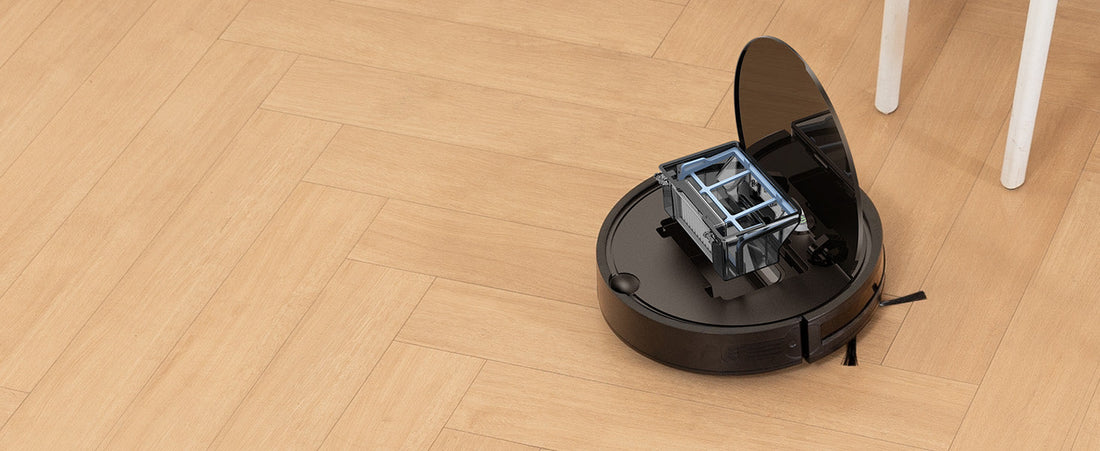That moment when your trusty robot vacuum starts making a new sound - maybe a slight rattle, an unusual whine, or worse, a concerning grinding noise. Your first thought might be: "Is this normal, or is my robotic helper trying to tell me something's wrong?"
The truth is, robot vacuums communicate through sound, and learning to understand their "language" can save you from costly repairs down the line. Let's become noise detectives together and figure out what your robot is trying to tell you.
The Normal Sounds: What to Expect from a Healthy Robot
Typical Operating Noises
A well-functioning robot vacuum should make:
-
A consistent hum from the motor
-
Gentle brushing sounds from the main brush
-
Soft clicking when changing directions
-
Quiet beeps for notifications or errors
-
Smooth whirring during normal operation
Volume Expectations
-
Normal operation: 55-65 dB (similar to a conversation)
-
Maximum suction: 65-75 dB (comparable to a standard vacuum)
-
Quiet mode: 45-55 dB (library-level quiet)
Common Problem Sounds and What They Mean
The "I've Got Something Stuck" Sounds
Grinding or Crunching Noise
-
What it sounds like: Gravel in a blender
-
Likely causes: Small objects caught in brushes, hair wrapped around axles
-
Quick fix: Turn off immediately, check brush chamber, remove debris
Clicking or Tapping Rhythm
-
What it sounds like: Tiny hammer tapping rapidly
-
Likely causes: Loose object in dustbin, foreign material in brush
-
Quick fix: Empty dustbin completely, inspect brush area
The "My Parts Are Wearing Out" Sounds
High-Pitched Whining
-
What it sounds like: Small electric motor straining
-
Likely causes: Worn motor bearings, belt issues
-
Action needed: May require professional service
Rattling or Vibration Noise
-
What it sounds like: Marbles in a tin can
-
Likely causes: Loose parts, worn brush bearings, damaged wheels
-
Quick fix: Tighten accessible screws, check for visible damage
The "I'm Struggling" Sounds
Intermittent Humming
-
What it sounds like: Motor starting and stopping
-
Likely causes: Blockage in airflow, filter issues
-
Quick fix: Check filters, clear air pathways
Loud Bumping or Thumping
-
What it sounds like: Something hitting plastic repeatedly
-
Likely causes: Obstacle detection issues, sensor problems
-
Quick fix: Clean sensors, check for navigation errors
Step-by-Step Audio Diagnosis Guide
The 30-Second Sound Check
-
Stop cleaning and listen carefully
-
Identify the sound type (grinding, whining, clicking)
-
Locate the source (front, back, sides)
-
Note when it occurs (always, only on carpets, when turning)
Quick Fixes to Try Immediately
-
Power off and restart - solves many electronic glitches
-
Clean all brushes - remove hair and debris
-
Check wheels and axles - remove wrapped fibers
-
Empty and clean dustbin - ensure proper airflow
-
Inspect filters - clean or replace if dirty
When to Worry: Sounds That Need Professional Attention
Red Flag Noises
-
Metal-on-metal grinding - immediate shutdown required
-
Electrical buzzing or sparking sounds - unplug immediately
-
Smell of burning with unusual noises - stop using immediately
-
Complete silence when should be running - electrical issues
The "Call for Help" Sounds
These typically indicate needs for:
-
Motor replacement
-
Bearing repairs
-
Electronic board issues
-
Major component failure
Preventive Maintenance: Keeping the Peace Quiet
Daily Quick Checks
-
Visual inspection before each clean
-
Quick brush clean after each use
-
Dustbin emptying after every session
-
Sensor wipe with dry cloth
Weekly Deep Maintenance
-
Remove and clean all brushes
-
Check wheel movement
-
Clean filter thoroughly
-
Inspect for wear and tear
Monthly Professional-Level Care
-
Deep clean all sensors
-
Check belt tension (if applicable)
-
Lubricate moving parts (if recommended)
-
Update software for performance improvements
The Vactidy Cleanova W11 Advantage: Designed for Quiet Operation
The Vactidy Cleanova W11 (marketed as Vexilar W11 in certain international markets) is engineered with noise reduction in mind. Its advanced LiDAR Technology for Precise 360° Scans allows for efficient navigation that reduces unnecessary bumping and redirection - common sources of extra noise in less advanced models.
The 5000 Pa Strong Suction Power is achieved through efficient motor design that minimizes vibration and noise while maintaining cleaning performance. The 2-in-1 Vacuuming and Wiping system operates smoothly without the jerky movements that can cause additional noise in some dual-function robots.
What makes the Cleanova W11 particularly good for noise-sensitive households is its balanced approach to power and quiet operation. The 180 Minutes Running Time is achieved through efficient power management that reduces motor strain, while the regular software updates often include noise optimization improvements.
Creating a Quiet Cleaning Environment
Home Setup for Peaceful Operation
-
Run during daytime hours when household noise masks vacuum sounds
-
Close doors to contain sound in specific areas
-
Use area rugs to dampen noise on hard floors
-
Schedule cleaning when home is empty if noise is a concern
When to Consider an Upgrade
If your current robot:
-
Consistently makes concerning noises despite maintenance
-
Has become significantly louder over time
-
Makes noises that worry pets or family members
-
Requires frequent repairs for noise-related issues
Your Noise Troubleshooting Toolkit
Keep These Handy
-
Small scissors for cutting wrapped hair
-
Compressed air for cleaning sensors
-
Soft brushes for dust removal
-
Replacement filters for regular changes
-
Manufacturer's contact information for when DIY isn't enough
Know When to Step Back
Some problems are best handled by professionals. If you're unsure about a noise or repair, contact:
-
Manufacturer support
-
Authorized repair centers
-
Professional cleaning appliance technicians
Remember: regular maintenance is the best prevention against concerning noises. A well-cared-for robot vacuum will not only last longer but will also operate more quietly and efficiently.
Your robot vacuum's sounds tell a story about its health and needs. Learning to listen and respond appropriately will keep your robotic helper running smoothly for years to come.

